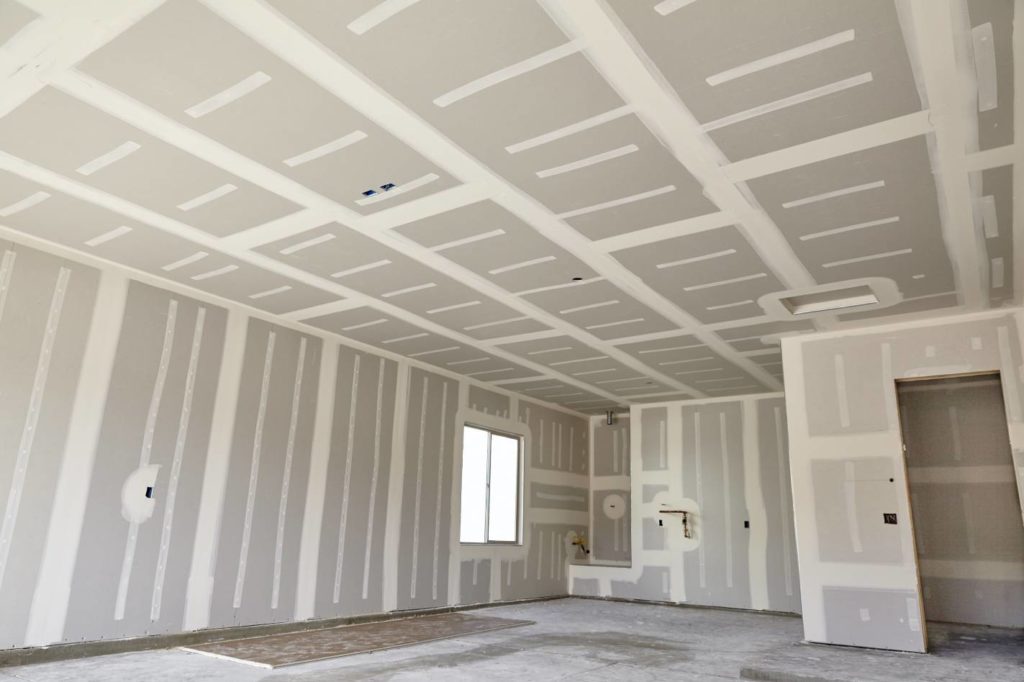When Was Drywall Invented? History of Drywall
-

- Last updated:

Drywall is one of the most common building materials in the modern world. Drywall is used everywhere, from commercial buildings to new homes, older homes, schools, offices, and more. Millions of square feet of drywall are produced and installed every year. Almost everyone is likely sitting next to drywall if they are inside right now. Given how popular drywall is today, when was it invented? Is drywall a new invention or an ancient one?
This brief overview will cover the basic history of drywall from its humble beginnings until the present day.

When Was Drywall Invented?
The first prototype of drywall was patented in 1894 by a man named Augustine Sackett. He called his prototype Sackett Board. The prototype was supposed to save time and money on traditional plaster walls, which were heavy and expensive to install for lower-class citizens.
Sackett Board was a precursor to the modern drywall that we know today. In 1916, US Gypsum Corporation (USG) integrated a variety of different industries into one company focused on producing modern drywall. USG is still America’s largest gypsum company. US Gypsum patented the name Sheetrock, which is still a common moniker for drywall today.
Many people put the official start day for modern drywall in 1916, but USG’s success would not have been possible without Augustine Sackett’s Sackett Board in 1894.

Why Was Drywall Invented?
Drywall was initially invented to try and save costs on plaster. Plaster was one of the most common materials for walls and ceilings, but by the end of the 19th century, it was getting more expensive to use. As populations grew and builders were tapped to build more housing for less money, they started looking for an alternative to traditional plaster that would help their bottom lines.
Later, it was found out that gypsum is extremely fire resistant. After gypsum’s potential as a fire retardant was discovered, it was sold as a way to help save your home from a fire. Plaster and wood were highly flammable, and in the late 19th and early 20th centuries, urban fires were still a terrifying problem. Cities and towns were still at risk of a fire breaking out at a factory, warehouse, or home and rapidly spreading to nearby flammable buildings.
It was in late 1871 when the Great Chicago Fire decimated one of America’s largest cities. The thought of major fires was still on everyone’s mind. Gypsum was sold as a way to cut down on the number of fast-spreading fires in tightly packed urban environments. Since the drywall was slower to burn and harder to light, it would prevent houses from catching as quickly as they did before. The sales tactic started working, and gypsum started to slowly catch on throughout the first part of the 20th century.
When Did Drywall Become Popular?
Drywall is a relatively new invention compared to materials like plaster. But when did the drywall boom start to take off? From 1916 until 1940, USG focused on expanding its market share, but plaster was still entrenched as the leading building material. It was hard to change centuries of tradition overnight. What helped drywall explode in popularity was World War II and the years directly following.
World War II saw severe rations put in place on common materials. Everything from grain, fertilizer, and aluminum was put under ration for many Americans. The rationing also extended to common building materials like lumber and plaster. This helped drywall immensely.
Since plaster and lumber were kept under wraps during the war effort, drywall had an opportunity to move into the market.
Boomtowns in places like Washington, DC, San Francisco, San Diego, and Honolulu had hundreds of buildings go up in just months. The affordability and availability of drywall made it the perfect material to make a difference.
After the war, the building boom continued. As millions of soldiers came home from overseas, they wanted to build or buy houses and settle down. The building that took place between 1945 and 1960 utilized drywall in greater quantities than ever before. The Baby Boomer housing boom really cemented drywall’s place as a leading American building material.

Drywall Today
According to market data, the demand for drywall has risen by 6000% since 1930. Today, over 20 billion square feet of drywall are produced in North America alone. That makes up billions of dollars in sales every year. Drywall continues to be used in every type of construction and looks to continue to dominate the market in the future. Drywall is still prized for its affordability, ease of installation, and firebreak capabilities. US Gypsum continues to dominate the drywall market. US Gypsum has an annual revenue of roughly $3 billion per year.
Drywall started as a new competitor to plaster in the early 20th century and quickly expanded to dominate the construction industry in just a few decades.

Conclusion
Drywall is a relatively new invention in the grand scheme of history. It made its large commercial debut in 1916 and has been going strong ever since. The Gypsum Association believes that there are roughly 350 years’ worth of gypsum available on Earth, so drywall is likely here to stay for the foreseeable future. Drywall is easy to get, easy to install, and affordable, and it helps slow residential fires. Those are still the reasons why people love drywall to this day.
Featured Image Credit By: DUO Studio, Shutterstock
Contents
